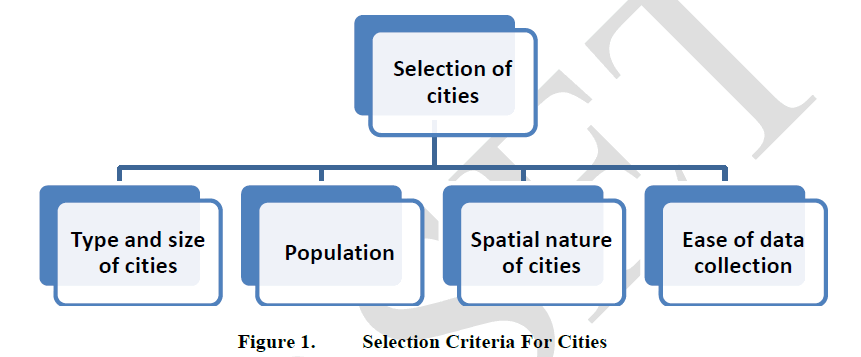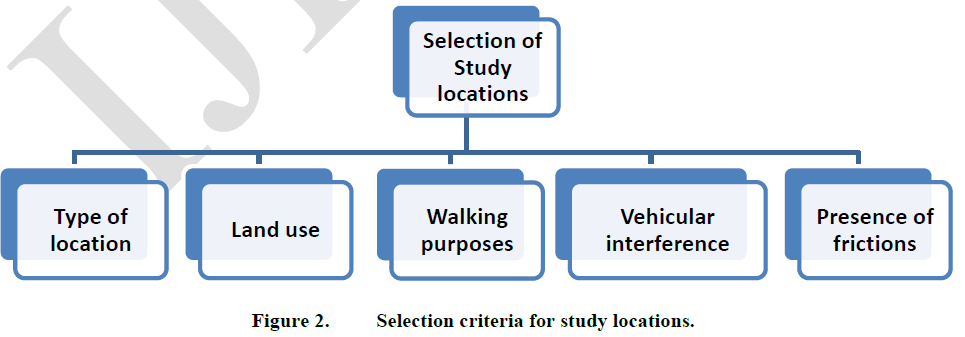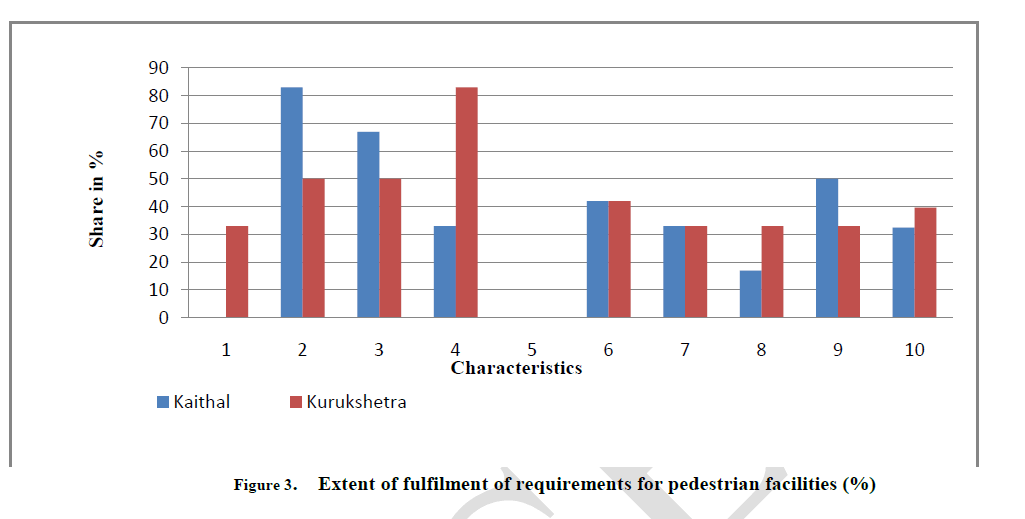ISSN ONLINE(2319-8753)PRINT(2347-6710)
ISSN ONLINE(2319-8753)PRINT(2347-6710)
Chitranshu Saluja 1, Bhavana Arora 2
|
| Related article at Pubmed, Scholar Google |
Visit for more related articles at International Journal of Innovative Research in Science, Engineering and Technology
Sidewalks play an important role in transportation, as they provide a safe path for people to walk along that is separated from the motorized traffic. In suburban areas, sidewalk helps to provide equal access to people who cannot drive, notably children, the elderly and the economically disadvantaged. Sidewalks also play an important role in accommodating people that, while perfectly able to drive, may choose not to depending on the length and type of trip they are undertaking - such as a walk to a local shop, a walk for recreation or physical exercise, or taking a pet (such as a dog) for a walk. High densities, mixed land use patterns, short trip distances and high share of walk are major characteristics of Indian cities. But, many of Indian towns and cities are not friendly to the pedestrian movements. The safety of pedestrians has been seriously affected by the rapid growth of vehicular traffic and inadequate pedestrian network especially in the Central Business Districts. The pedestrians are further affected by the urban air pollution and noise pollution. Pedestrians are expected to walk on the sidewalk constructed on the side of the carriageway. Most of the times, these sidewalks are encroached by road-side development or occupied by vendors and hawkers. In case sidewalks are available, then a buffer area is provided for the pedestrians but those buffers are either occupied by parked vehicles or encroached by other users. As a result pedestrians are forced to walk on the carriageway. Not many comprehensive studies on pedestrian sidewalk facilities and assessment of their safety and quality have been taken up especially in the mid sized cities in the country. Absence of sidewalk wherever necessary, deteriorated conditions of footpath, encroachments of footpath, presence of footpath wherever pedestrian movement is negligible are some of the problems to be studied. As pedestrians are the most vulnerable among road accident victims, the study aims to highlight the need for providing better sidewalk facilities for pedestrians to save them from road accidents.
KEYWORDS |
| sidewalk, pedestrian, footpath |
I. INTRODUCTION |
| Walking is the most important mode, which helps in decreasing air pollution caused due to high automobile usage. It also promotes physical and mental health of people who walk. It is the most effective and efficient mode of transportation for short trips upto 1-2 km in length. |
| The study aims at assessing the quality and safety of sidewalks for pedestrians in two mid-size cities of Kaithal and Kurukshetra. |
| The main objectives of the study are: |
| 1. To study the footpaths and main roads of Kaithal and Kurukshetra. |
| 2. To study physical characteristics of footpaths in these cities that affects their quality and safety aspects. |
| 3. To study user characteristics of footpaths in these two cities that affects their quality and safety aspects. |
| 4. To bring out overall quality and safety assessment of footpaths of selected roads/locations. |
| 5. To determine the share of pedestrians using footpaths and the adjoining carriageways. |
II. METHODOLOGY AND DATA COLLECTION |
| The methodology adopted for the present study is explained in successive steps below. |
i. Selection of cities |
| The present study aims at quality and safety assessment of pedestrian sidewalk facilities for two mid sized cities having population around 10 lacs. Two cities were identified meeting these criteria of population and size. These two cities of Kaithal and Kurukshetra in Haryana were selected for study due to ease of data collection, one being my hometown and other being the nearest city. Figure1. gives the selection criteria for cities. |
 |
ii. Selection of study locations |
| The study locations within a city were identified based on the following criteria: |
| (i) Type of location |
| (ii) Land use |
| (iii) Walk purposes |
| (iv) Vehicular interference |
| (v) Presence of frictions |
 |
iii. Description of study areas and study locations |
| The cities that are identified for the present study are Kaithal and Kurukshetra. These are mid sized cities with population about 10 lacs. |
| The study locations are chosen considering its type, adjacent land use and roadway characteristics. Land use of a facility is defined based on the type of activity in adjoining area. Accordingly, the locations are classified as commercial, shopping, mixed, educational, recreational and residential. Commercial area represents the area being used for commercial purposes usually with high pedestrian movement on the facility. Shopping area implies the presence of shops on either side of road or an exclusive shopping mall or shopping street. Educational area represents the area with schools. Mixed land use represents the area with combination of activities like commercial, shopping etc., taking place in the same area. Recreational area corresponds to the area being used for purposes like leisure walk, morning stroll, exercise, sightseeing etc. |
Kaithal |
| The city of Kaithal is based on its size, population and the strategic importance. It has a population of 9,46,131. It is one of the fastest growing cities of Haryana. |
Kurukshetra |
| It is the city of temples having both historical and religious importance. It is one of the major cities of Haryana with large number of visitors every year. It has a population of about 9 lakhs and covers an area of 1530 km2. It is famous for Brahm Sarovar. |
iv. Data Collection |
| The data related to various aspects of sidewalks was collected manually as well as by taking still photographs. The data collected manually includes features like pedestrian volume, footpath width, kerb height and type of footpath surface. Apart from this, location of trees, electric poles, cleanliness, obstructions, encroachments etc were observed and photographs were taken. |
 |
 |
III. CONCLUSIONS |
| The study on “Quality and safety assessment of pedestrian sidewalk in Two Mid-sized cities of Haryana” has been made in Kaithal and Kurukshetra. The study involves assessment of physical characteristics and user characteristics of footpaths and pedestrians as per the norms prescribed by IRC-103-2012. The main conclusions drawn from the study are as under : |
| 1. In Kaithal and Kurukshetra, the adequacy of footpath width is found to be 0% and 33% respectively which is very less. The main reasons for inadequacy of footpath width are lack of space on the sides of the carriageway due to less importance given to the pedestrian facilities at the planning stage as well as lack of awareness about pedestrian safety among engineers and planners. |
| 2. In respect of footpath surface, 83% of the footpaths in Kaithal meet the specified requirements whereas in Kurukshetra 50% footpaths are as per norms. It is observed that the footpaths are made of concrete tiles or other such materials which are as per prescribed norms, but the surface of footpaths is uneven leading to discomfort of pedestrians. This unevenness of surface may be attributed to the lack of quality control during construction and negligent maintenance later on by the authorities. |
| 3. As far as obstruction on footpaths is concerned, 67%of the footpaths in Kaithal are obstruction free and about 50% of footpaths in Kurukshetra are free from obstructions. Trees, sign boards and hoardings are found to be the main type of obstructions on the footpaths |
| 4. In case of encroachment of footpaths, the situation in Kaithal and Kurukshetra is just opposite of obstructions, i.e., 83% of the footpaths in Kurukshetra have no encroachment whereas only 33% of the footpaths in Kaithal are free from encroachment. This is due to large number of commercial activities in Kaithal. Vendors, hawkers an extension of kiosks/shops are found to be the main types of encroachments on the footpath. |
| 5. In both the cities, continuity characteristic of footpaths in terms of kerb ramps is found to be totally absent. The footpaths are observed to be non-continuous with frequent kerb cuts which not only cause discomfort to users especially the old age and disabled people but also impede traffic flow with more chances of accidents of pedestrians with traffic. The lack of continuity may be attributed to the lack of awareness about pedestrian safety. |
| 6. About 42% of the footpaths both in Kaithal and Kurukshetra meet the requirements of potential for vehicle conflict. The footpaths are found to be segregated from traffic by providing raising but this raising but this raising was found to be on the higher side than the standard public step riser of 150 mm in case of many of footpaths. The guard rails are also found to be either not provided or their height and design is found to be lacking for many of the sites. |
| 7. For the feeling of safety and security among pedestrians, 33% of sidewalks in both Kaithal and Kurukshetra fulfil the specified requirements. Lack of street lighting, sufficient activities in in the surrounding areas and separation of pedestrians from vehicular traffic are found to be the cause of concern for many footpaths. |
| 8. In case of pedestrian’s comfort, 17% of footpaths in Kaithal and 33% of footpaths in Kurukshetra fulfil the norms. Shady trees are found near many footpaths but features like washrooms, rain shelters and benches/chairs are mostly missing. |
| 9. Walk environment in terms of cleanliness and stink free surroundings is fulfilled by 50% of sidewalks in Kaithal and 33% in Kurukshetra. This is due to lack of proper maintenance of footpaths. |
| 10. Overall, 32.5% of footpaths in Kaithal and 39.5% in Kurukshetra are found to comply with quality and safety norms. |
| 11. A higher number of pedestrians are found to use the footpath than the adjoining carriageway when the footpath is provided as per norms. |
| 12. The main reason for pedestrian sidewalks not complying to the quality and safety norms is the lack of awareness about pedestrian safety among engineers and planners and less importance given to the pedestrian facilities at various stages of planning, construction and maintenance. |
References |
|